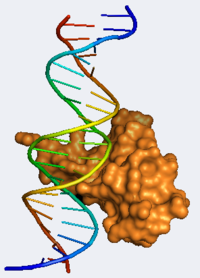Methyl CpG Binding Protein 2
From Proteopedia
(Difference between revisions)
| (10 intermediate revisions not shown.) | |||
| Line 1: | Line 1: | ||
<StructureSection load='3c2i' size='500' side='right' background='none' scene='Methyl_CpG_Binding_Protein_2/Opening/3' caption='Structure of MeCP2 complex with methylated DNA, [[3c2i]]'> | <StructureSection load='3c2i' size='500' side='right' background='none' scene='Methyl_CpG_Binding_Protein_2/Opening/3' caption='Structure of MeCP2 complex with methylated DNA, [[3c2i]]'> | ||
| - | [[Image:Mecp2 picture.png|200px|left]] | + | [[Image:Mecp2 picture.png|200px|left]] |
| + | {{Clear}} | ||
| + | [[Methyl CpG Binding Protein 2]] ('''MeCP2''') is a transcriptional repressor that plays a critical gene silencing role. It binds the methylated BDNF [[DNA]] sequence with exquisite specificity and recruits repressor complexes which include chromatin-remodeling enzymes.<ref name="Bird"/> MeCP2, encoded by an X-linked gene, has been found in most tissues but is primarily localized to cortical neurons where it is believed to help modulate neuronal maturity and plasticity.<ref>PMID:14593168</ref> It also plays a crucial role in synaptogenesis and in maintaining proper neuronal function.<ref name="Bird">PMID:18313390</ref> Of particular note, mutations within the MeCP2 gene are responsible for over 95% of cases of Rett Syndrome. Rett Syndrome (RTT) is an [[Autism|autism]] spectrum neurodevelopmental disorder caused by the expression of mutant MeCP2 . RTT patients present with abnormal neuronal morphology and have a large spectrum of autistic characteristics such as impaired motor function and impaired developmental skills. These symptoms become first evident 6-18 months after birth.<ref>PMID:21074045</ref> Intriguingly, Guy et al. demonstrated that the restoration of neuronal function by knock-in expression of MeCP2 in mice can reverse many of the RTT phenotypic traits.<ref>PMID:17289941</ref> | ||
| + | '''MeCP2''' is present in mature nerve cells and is involved in turning off several genes. | ||
====Structure of MeCP2==== | ====Structure of MeCP2==== | ||
| Line 13: | Line 16: | ||
This article was developed based on lectures given in Chemistry 543 by Prof. Clarence E. Schutt at Princeton University. | This article was developed based on lectures given in Chemistry 543 by Prof. Clarence E. Schutt at Princeton University. | ||
| - | == | + | ==3D structures of MeCP2== |
| - | + | ||
| - | [[ | + | See [[Methyl CpG binding protein]]. |
| - | + | ||
| - | + | ==See Also== | |
| - | [[ | + | * [[Introduction to Evolutionary Conservation]] which uses MeCP2 as an example. |
| - | [ | + | * [http://www.umass.edu/molvis/workshop/slides/rett/rett.htm Brief introduction to Rett Syndrome] |
| - | + | ||
| - | + | ||
==References== | ==References== | ||
Current revision
| |||||||||||
Contents |
Page Development
This article was developed based on lectures given in Chemistry 543 by Prof. Clarence E. Schutt at Princeton University.
3D structures of MeCP2
See Methyl CpG binding protein.
See Also
- Introduction to Evolutionary Conservation which uses MeCP2 as an example.
- Brief introduction to Rett Syndrome
References
- ↑ 1.0 1.1 1.2 1.3 Ho KL, McNae IW, Schmiedeberg L, Klose RJ, Bird AP, Walkinshaw MD. MeCP2 binding to DNA depends upon hydration at methyl-CpG. Mol Cell. 2008 Feb 29;29(4):525-31. PMID:18313390 doi:10.1016/j.molcel.2007.12.028
- ↑ Zoghbi HY. Postnatal neurodevelopmental disorders: meeting at the synapse? Science. 2003 Oct 31;302(5646):826-30. PMID:14593168 doi:10.1126/science.1089071
- ↑ Marchetto MC, Carromeu C, Acab A, Yu D, Yeo GW, Mu Y, Chen G, Gage FH, Muotri AR. A model for neural development and treatment of Rett syndrome using human induced pluripotent stem cells. Cell. 2010 Nov 12;143(4):527-39. PMID:21074045 doi:10.1016/j.cell.2010.10.016
- ↑ Guy J, Gan J, Selfridge J, Cobb S, Bird A. Reversal of neurological defects in a mouse model of Rett syndrome. Science. 2007 Feb 23;315(5815):1143-7. Epub 2007 Feb 8. PMID:17289941 doi:10.1126/science.1138389
Proteopedia Page Contributors and Editors (what is this?)
David Canner, Michal Harel, Eric Martz, Jaime Prilusky, Alexander Berchansky

